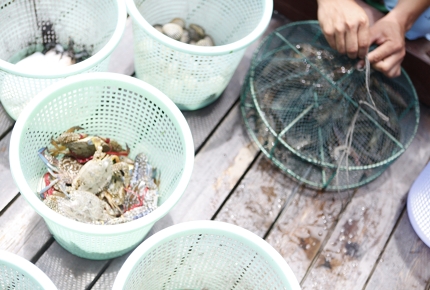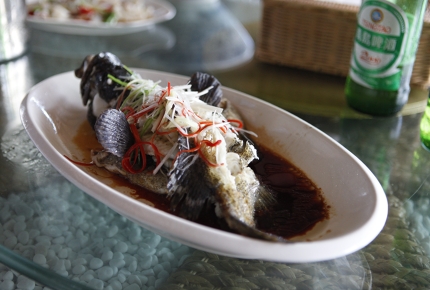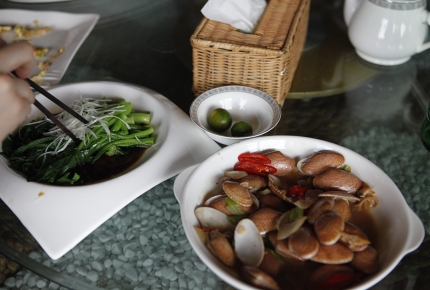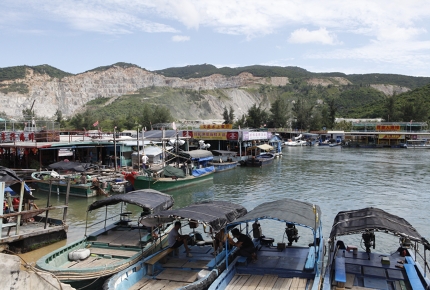Eating with the Egg People, China
Daniel Fahey makes a reservation at one of the most unique restaurants in the world: aboard a buoyant bistro run by the Egg People of Hainan Island, China.
Tony squealed at what might be the greatest gag he’s ever told. Spittle sprung from his tongue, his eyes went loose and he threw a clumsy arm around my neck.
Clearly, I was part of the joke, perhaps even the punch line, but I couldn’t tell how funny it was because my Chinese was worse than his English, and his English had been drinking.
Still, when he shared it for a second time, slapping his thigh like a comic cymbal crash, I hooted contagiously as if I’d gotten it.
I tried to lure him back to our plates of supple beef noodles and polished, oily oysters, but he was busy repeating the quip to his towering, shaved headed friend, Mr Do.
Mr Do stared straight ahead, listening intently. Suddenly his eyes lit up as if they’d come into focus and he sniggered uncontrollably. Clearly it was a corker.
It was my final night on China’s Hainan Island and a pedigree moon loomed over the neon advertising boards of the Haikou night market. The lunar marvel was losing the brightness battle to some brand of Chinese beer.
I’d come in search of local food, but what I discovered was a menu of three very different, extraordinarily Chinese ways of eating.
The starter: Hand-caught flower crabs and yellow lantern chilli with aged Egg
 A Dan fisherman gets his catch ready for the plate
A Dan fisherman gets his catch ready for the plateDora Whitaker / Lonely Planet
I was watching it die, but I couldn’t look away. In a final, futile fight for life, the shrimp convulsed, vaulted and then rattled back into the plastic basket. The fisherman scooped it up and slapped it onto a set of industrial scales, making a note of the weight.
Minutes earlier, the shrimp had been unaware of its fate. It was happily submerged under an artichoke-coloured river that crawled past Haitang Bay near China’s most southern outpost.
It had been pedalling the tides alongside tiger grouper, rainbow crabs and petite clams, but that was every bit a sham. All of them had long been caught by the 'Egg People' (the nomadic fishermen who live along the country’s southern shores) and were simply surviving in the shallows of a giant net tied to a buoyant bistro.
The 'Egg People' had employed these practises for centuries - that's where their name stems from. They're actually called the Dan, which translates to ‘Egg’ in Chinese and represents the floating motion of an egg in water. It's a trait they mirror on their boats.
Back during the Song dynasty, they caught fish and collected pearls from the South China Sea, living aboard bamboo boathouses decorated with simple clay tiles. Communities would school children, rear chickens and share meals on the waterways; some only ever went ashore in a casket.
There are few Dan making a living on the waves these days and even fewer chances to eat with them. When we motored downstream from the dusty, disintegrating steps of Houhai Pier, our boat was fibreglass not bamboo and it was powered by diesel rather than people.
 A steamed tiger grouper covered in cucumber and chilli shavings
A steamed tiger grouper covered in cucumber and chilli shavingsDora Whitaker / Lonely Planet
The fisherman disappeared into the kitchen with his bounty. Half a Tsingtao later, our circular table was spinning with bowls of creamy crab congee (rice porridge), racks of simmered flower crab ready for dismantlement, soft kai-lan (Chinese broccoli) drizzled in an oyster dressing and a fiery sauce made from Hainan’s yellow lantern chilli.
The pink prawns and pop-in-the-mouth rainbow shells tasted as wonderful as they appeared, but the culinary centrepiece was the steamed tiger grouper covered by cucumber and chilli shavings.
We pulled at its soft skin and quibbled over the delicate cheek meat, but instead of flipping the fish to get at the flesh below, we went through its bones with our chopsticks. This is a Dan custom - turning the grouper could rock the boat, something that would bring bad luck.
The main course: Chicken feet from the street served with candied mayhem
Haikou’s street stalls swung out after 9pm when the shop shutters slid down. It was like being at the funfair: hawkers sold spicy grilled squid on sticks and ‘stinky tofu’ (refried rotten tofu) saddled in a coriander broth. Cars cut through the street like fairground rides; motorbikes revved around booths, buzzing like excitable children.
If they weren’t the entertainment, the neon signs were. They burst and bloomed with attention-grabbing colour but the locals had seen it all before.
 The author tries some kai-lan drizzled in an oyster dressing
The author tries some kai-lan drizzled in an oyster dressingDora Whitaker / Lonely Planet
At least the duck’s throat had a kick – a peppery, burning tang that scorched the taste buds. Coconuts were beheaded in the road; their blood rejuvenated.
I walked past the red teeth and stained street corner of the areca nut sellers who were alert through their own wares. They offered a complementary taste. I chewed the churn of an addict; it was bitter and unpleasant, but I wanted more, and went in search of some among the tobacconists and sweet shops.
For dessert: Soft-shell crabs and soft monkey nuts served with a side of Mr Do
Late into my last evening, I’d made my way to Haikou night market for beer. A three-litre lager dispenser was placed down on the table and soft monkey nuts were poured around it. Thin white fish, grilled and smothered in sesame seeds were brought over on plates.
Chopsticks were handed out, and then fumbled, as they twisted tiny soft-shell crabs into their grip. The crabs, no bigger than a 50p piece, came with thick-cut onions and were to be eaten whole. I savoured their garlic covers as I crushed them into my gums.
That’s when Tony and Mr Do arrived. More beer was ordered, dice were rolled. Everything and anything got lost in translation. A waitress fetched a carton of cigarettes; there were cheers of “Ganbei” and continuous toasts. Then Tony started running off one-liners…
 Boats wait for customers down by Houhai Pier, China
Boats wait for customers down by Houhai Pier, ChinaDora Whitaker / Lonely Planet
NEED TO KNOW
Getting there
There are no direct flights from the UK to Hainan Island. However, Hainan Airlines (global.hnair.com) fly from Beijing to Haikou Meilan International Airport on the north of the island and to Sanya Phoenix International Airport in the south.
Houhai Pier, where you can get boats to eat with the Dan People, is a few hours drive by car from either airport. Get a guide to take you to Haitang Impression Seafood Restaurant (tel: +86 138 7669 2525) as the owners don’t speak English.
Where to stay
The wonderful Westin Hotel at Haitang Bay (www.starwoodhotels.com) comes with spacious suites, sea views, its own private beach and a huge snaking swimming pool. The chefs also whip up local delicacies like poached Wenchang chicken and Dongshan lamb.
More information
Hainan Tourism: en.visithainan.gov.cn
Haitang Impression Seafood Restaurant (tel: +86 138 7669 2525) can be reached from Hou Hai Pier, Tie Lu Gang.
Do you have any Feedback about this page?
© 2026 Columbus Travel Media Ltd. All rights reserved. No part of this site may be reproduced without our written permission, click here for information on Columbus Content Solutions.









 You know where
You know where